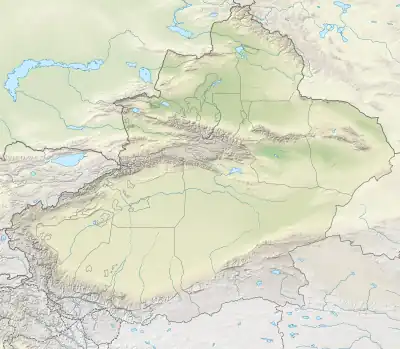Tongtiandong
Tongtiandong (Chinese: 通天洞, Tōngtiāndòng) is an archaeological site in the Xinjiang Autonomous Region of China, just to the south of the Altai mountains. The site had hunter-foraging human activity circa 40,000 BP (the Mousterian cultural layer was radiocarbon dated to approximately 46,000–44,000 BP, calibrated).[1][2][3]
 Typical artifacts of the TMP ("Terminal Middle Paleolithic" ~50–38 ka BP) techno-complex found in the Tongtiandong Cave site of Northwest China (1: Levallois core; 2: Discoid core; 3: Levallois flake; 4,5,6: Levallois points; 7,10,11: Mousterian point; 8,9: Scraper; 1–11).[1] | |
.png.webp) Location in China  Tongtiandong (Xinjiang) | |
| Region | Xinjian China |
|---|---|
| Coordinates | 47.006093°N 85.980127°E |
| History | |
| Founded | 46,000–44,000 BP cal |
| Periods | Paleolithic China |
Cave
Until the discovery of Tongtiandong, the typical Mousterian techno-complex had not been identified in China, but the whole reduction sequence of the Mousterian techno-complex has now been identified in Tongtiandong cave.[4]
From Tongtiandong and other sites, a general distributional pattern of different techno-complexes between Mongolia-Siberia and northern China can be established, for the dates between 50,000 and 32,000 cal BP.[1]

1: Okladnikov Cave; 2: Strashnaya cave; 3: Denisova Cave; 4: Ust Karakol; 5: Kara-Tenesh; 6: Tongtiandong; 7: Mokhovo-2; 8: Kharganyn Gol-5; 9: Orkhon-1; 10: Jinsitai; 11: Sanlongdong cave; 12: Kara-Bom; 13: Luotuoshi; 14: Chikhen Agui; 15: Tsagaan Agui; 16: Voenny Hospital; 17: Kamenka; 18: Tolbaga; 19: Tolbar-4; 20: Nwya Devu; 21: Lenghu; 22: Yushuwan; 23: Lenghu-.1; 24: Shuidonggou-2; 25: Changweigou; 26: ZS08; 27: Wulanmulun; 28: Longquandong; 29: Zhijidong; 30: Fangjiagou; 31: Zhaozhuang; 32: Laonainaimiao; 33: Xiachuan (Fuyuhe); 34: Xibaimaying; 35: Xigouwan; 36: Xiaogushan; 37: Mingyuegou; 38: Zhoujiayoufang; 39: Guxiangtun; 40: Zhalainuoer; 41: Shiyu; 42: Zhoukoudian Upper Cave.[5]
Terminology
- TMP: Terminal Middle Paleolithic (~50–38 ka BP)
- IUP: Initial Upper Paleolithic (~43-32ka BP)
References
- Zhao, Chao; Wang, Youping; Walden, John P. (3 November 2022). "Diachronic shifts in lithic technological transmission between the eastern Eurasian Steppe and northern China in the Late Pleistocene". PLOS ONE. 17 (11). doi:10.1371/journal.pone.0275162. ISSN 1932-6203. PMC 9632798.
- Betts, Alison; Vicziany, Marika; Jia, Peter Weiming; Castro, Angelo Andrea Di (19 December 2019). The Cultures of Ancient Xinjiang, Western China: Crossroads of the Silk Roads. Archaeopress Publishing Ltd. p. 10. ISBN 978-1-78969-407-9.
"Recent excavations at the cave site of Tongtiandong in the southern Altai have revealed evidence for human activity at around 40 k BP (Yu and He 2017), and one other stratified but undated preBronze Age context is known, from the site...
- "45,000-Year-Old Stone Tools Recovered in China - Archaeology Magazine". Archaeology. 2018.
- Zhao, Chao; Wang, Youping; Walden, John P. (3 November 2022). "Diachronic shifts in lithic technological transmission between the eastern Eurasian Steppe and northern China in the Late Pleistocene". PLOS ONE. 17 (11). doi:10.1371/journal.pone.0275162. ISSN 1932-6203. PMC 9632798.
The typical Mousterian techno-complex was long considered absent from China due to a lack of convincing evidence [59]. However, recent discoveries reveal unequivocal evidence of this techno-complex distributed sporadically across peripheral areas of Northwest and Northeast China. At Tongtiandong Cave in Northwest China, the whole reduction sequence of the Mousterian techno-complex has been identified. This sequence comprised Levallois flake cores, Levallois flakes, points, and denticulates
- Zhao, Chao; Wang, Youping; Walden, John P. (3 November 2022). "Diachronic shifts in lithic technological transmission between the eastern Eurasian Steppe and northern China in the Late Pleistocene". PLOS ONE. 17 (11). doi:10.1371/journal.pone.0275162. ISSN 1932-6203. PMC 9632798.
 This article incorporates text by Zhao Chao available under the CC BY 4.0 license.
This article incorporates text by Zhao Chao available under the CC BY 4.0 license.